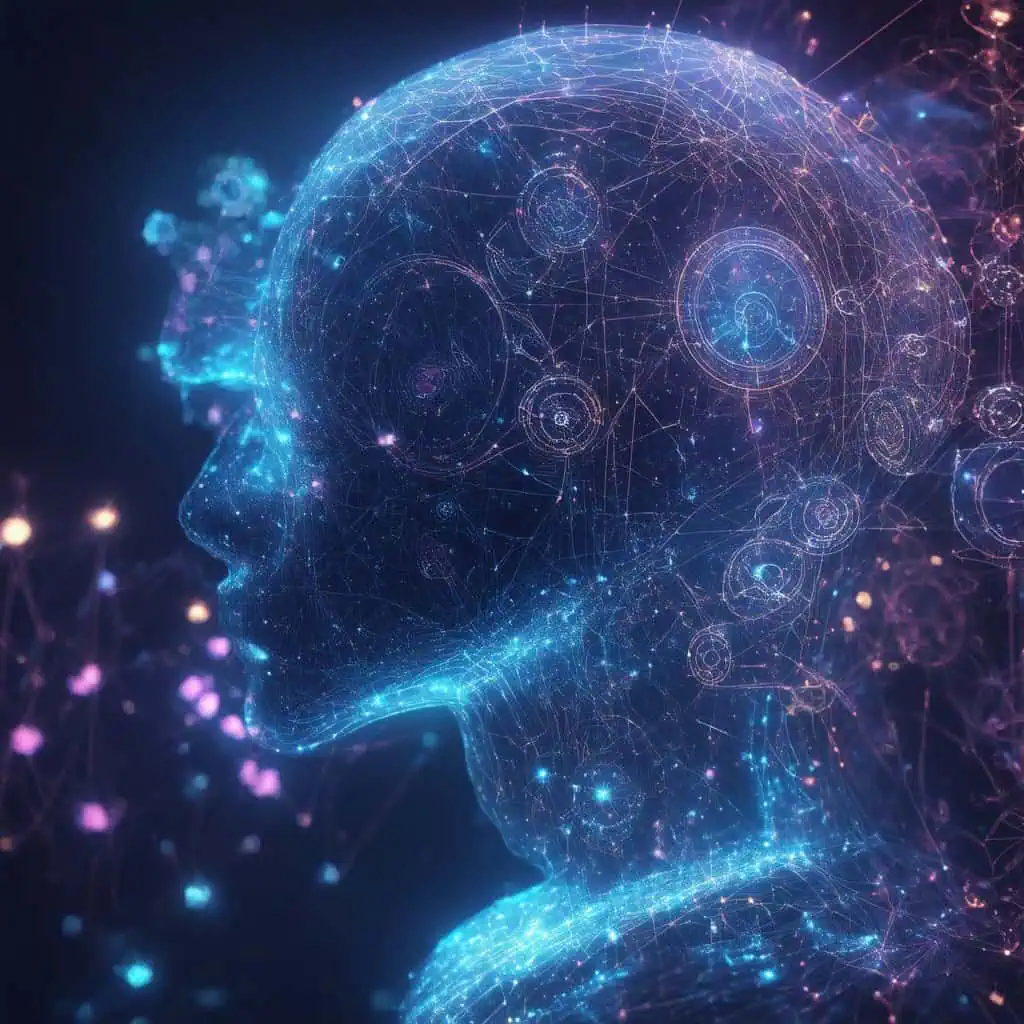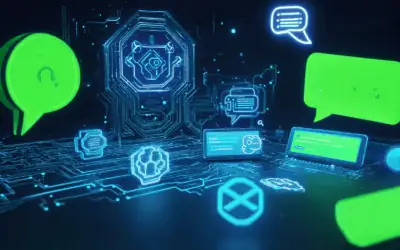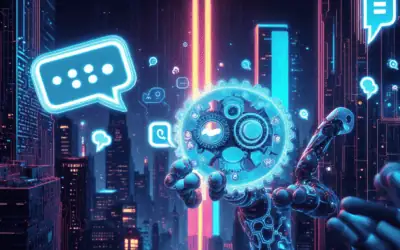Key Takeaways
- Conversational chatbots enhance user engagement by simulating human-like interactions, utilizing natural language processing (NLP) for effective communication.
- AI-powered chatbots can learn and adapt over time, providing personalized responses and handling complex queries, making them ideal for dynamic customer service environments.
- Key features of conversational chatbots include multi-channel support, integration capabilities with existing systems, and natural language understanding, improving overall user experience.
- Leading conversational AI solutions like Claude by Anthropic and IBM Watson Assistant offer robust functionalities that cater to various business and educational needs.
- Free conversational chatbot options such as Dialogflow and Botpress provide accessible tools for businesses and students to implement AI-driven interactions effectively.
- Understanding the four types of chatbots—menu-based, rule-based, AI-powered, and voice chatbots—helps businesses choose the right solution for their specific needs.
Welcome to our Comprehensive Guide to Conversational Chatbot Examples, where we delve into the fascinating world of conversational chatbots and their transformative impact on user interactions. In this article, we will explore the essential differences between conversational AI and chatbots, providing clarity on what sets these technologies apart. You will discover real-world applications of chatbots, showcasing how businesses leverage these tools to enhance customer engagement. Additionally, we will highlight the best chatbot examples available today, including free options for those looking to implement conversational chatbot examples in their operations. Whether you’re curious about AI chatbot examples or seeking insights into different types of chatbots, this guide is designed to equip you with the knowledge you need to navigate the evolving landscape of conversational AI. Join us as we uncover the potential of conversational chatbots and how they can revolutionize your interactions!
What is a Conversational Chatbot?
A conversational chatbot is an advanced software application designed to simulate human-like interactions through text or voice. These chatbots utilize natural language processing (NLP) and machine learning algorithms to understand and respond to user inquiries in a conversational manner. This technology enhances user engagement by providing quick, accurate responses, making it an essential tool for businesses looking to improve customer interactions.
Types of Conversational Chatbots
- Rule-Based Chatbots: These operate on predefined scripts and can only respond to specific commands or questions. They are limited in their ability to handle unexpected queries, making them suitable for straightforward tasks.
- AI-Powered Chatbots: These utilize conversational AI technologies, allowing them to learn from interactions and improve over time. They can understand context, manage complex conversations, and provide more personalized responses, making them ideal for dynamic environments.
Key Features
- Natural Language Understanding (NLU): This allows chatbots to comprehend user intent and context, making interactions more fluid and human-like.
- Multi-Channel Support: Many conversational chatbots can operate across various platforms, including websites, messaging apps, and social media, enhancing user accessibility.
- Integration Capabilities: They can be integrated with other systems, such as CRM tools, to provide users with tailored information and services.
What is the Best Conversational Chatbot?
The best conversational chatbot as of 2025 is Claude by Anthropic, recognized by CNET Editors as the top choice for its advanced conversational capabilities and user-friendly interface. Claude stands out in the crowded field of conversational AI solutions due to its impressive features and adaptability.
Best Chatbot Examples for Businesses
When considering examples of chatbots that excel in various business applications, Claude leads the pack. Its key features include:
- Natural Language Understanding: Claude excels in understanding context and nuances in conversations, making interactions feel more human-like.
- Multimodal Capabilities: It can process both text and images, allowing for richer interactions.
- Customization: Users can tailor Claude’s responses based on specific needs, enhancing its applicability across various industries.
Other notable chatbots include ChatGPT and Google’s Bard, which also offer robust features. However, Claude’s unique training data and algorithms provide a more coherent conversational flow, making it a preferred choice for many businesses.
Conversational Chatbot Examples Free: Top Options
For those exploring conversational chatbot examples for students or free options, several platforms offer accessible solutions. Here are some top choices:
- Brain Pod AI: This platform provides a range of conversational AI chatbots that can be tailored for educational purposes.
- Dialogflow: A Google product that allows users to create chatbots with customizable features, ideal for various applications.
- Botpress: An open-source solution that enables users to build their own chatbots, perfect for those looking to experiment with chatbot conversation flow examples.
These options provide excellent starting points for anyone interested in implementing conversational AI examples in educational settings or other environments.
What is a Chatbot with an Example?
A chatbot is an artificial intelligence (AI) program designed to simulate conversation with human users, particularly over the internet. Chatbots can be categorized into various types based on their functionality and application. Here are some prominent examples of chatbots:
- Virtual Assistants: These chatbots, such as Apple’s Siri and Amazon’s Alexa, help users perform tasks through voice commands, providing information, setting reminders, and controlling smart home devices.
- Customer Support Bots: Many companies deploy chatbots on their websites to assist customers with inquiries. For instance, Zendesk’s Answer Bot uses machine learning to provide instant responses to common customer questions, enhancing user experience and reducing wait times.
- E-commerce Chatbots: Bots like Shopify’s Kit help businesses manage their online stores by assisting with order tracking, product recommendations, and customer engagement, streamlining the shopping experience.
- Banking Bots: Financial institutions utilize chatbots, such as Erica from Bank of America, to assist customers with balance inquiries, transaction history, and even financial advice, making banking more accessible.
- Messenger Bots: Platforms like Facebook Messenger host bots that facilitate interactions between businesses and customers. For example, the Sephora chatbot on Messenger allows users to book appointments, receive product recommendations, and access beauty tips directly through the messaging app.
Chatbots are revolutionizing customer interaction by providing immediate responses, 24/7 availability, and personalized experiences, ultimately improving customer satisfaction and operational efficiency. According to a report by Gartner, by 2025, 75% of customer service interactions will be powered by AI, highlighting the growing importance of chatbots in various sectors.
AI Chatbot Examples: Leading Solutions in the Market
When exploring conversational AI examples, several leading solutions stand out in the market for their innovative approaches and effectiveness:
- Dialogflow: Developed by Google, Dialogflow is a powerful tool for building conversational interfaces, enabling developers to create chatbots that understand natural language and engage users effectively.
- IBM Watson Assistant: This AI-driven solution allows businesses to create chatbots that can handle complex queries and provide personalized responses, making it a popular choice for enterprises.
- Salesforce Einstein Chatbot: Integrated within the Salesforce ecosystem, this chatbot leverages customer data to deliver tailored interactions, enhancing the overall customer experience.
- Brain Pod AI: Known for its versatile AI solutions, Brain Pod AI offers a range of chatbot functionalities, including multilingual support and advanced analytics, making it a strong contender in the conversational AI space. Learn more about their offerings at Brain Pod AI.
These examples of conversational AI showcase how businesses can leverage technology to improve user engagement and streamline operations.
What are the 4 types of chatbots?
Understanding the different types of chatbots is essential for businesses looking to implement effective conversational AI solutions. Each type serves distinct purposes and functionalities, catering to various user needs and interaction styles. Here are the four primary types of chatbots:
- Menu or Button-Based Chatbots: These chatbots provide users with a predefined set of options to choose from, making interactions straightforward. Users select from buttons or menus to navigate through the conversation. This type is commonly used in customer service scenarios where specific queries can be addressed quickly.
- Rule-Based Chatbots: Also known as decision-tree chatbots, these operate based on a set of predefined rules. They follow a scripted flow and can handle simple queries effectively. However, their capabilities are limited to the scenarios they are programmed for, making them less flexible than other types.
- AI-Powered Chatbots: Utilizing natural language processing (NLP) and machine learning, AI-powered chatbots can understand and respond to user queries in a more human-like manner. They learn from interactions and improve over time, allowing for more complex conversations. This type includes advanced applications like virtual assistants and customer support bots that can handle a wide range of inquiries.
- Voice Chatbots: These chatbots use voice recognition technology to interact with users through spoken language. They are commonly integrated into smart devices and applications, allowing for hands-free communication. Voice chatbots are increasingly popular in home automation and customer service, providing a seamless user experience.
Conversational AI Use Cases: Exploring Different Types
Each type of chatbot has unique use cases that can enhance user engagement and streamline processes. For instance, conversational AI use cases span various industries, from customer service to education. Businesses can leverage these chatbots to automate responses, provide information, and improve overall user experience.
Chatbots vs Conversational AI: Which is Right for You?
When deciding between chatbots and conversational AI, it’s important to consider your specific needs. Chatbots are ideal for straightforward tasks and quick responses, while conversational AI offers a more sophisticated approach, enabling deeper interactions and learning capabilities. Understanding the differences can help you choose the right solution for your business.
Conversational Chatbot Examples for Students
Conversational chatbots have become invaluable tools in educational settings, providing students with interactive learning experiences and personalized support. These conversational chatbot examples demonstrate how AI can enhance student engagement and streamline educational processes.
1. AI Chatbot Examples: Leading Solutions in the Market
Several AI chatbots are specifically designed for educational purposes, offering features that cater to students’ needs. Here are some notable examples of chatbot solutions:
- Duolingo: This language-learning platform utilizes a conversational AI bot to help users practice languages through interactive dialogues, making learning engaging and effective.
- Woebot: A mental health chatbot that provides students with emotional support and coping strategies through friendly conversations, helping to reduce anxiety and stress.
- ChatGPT: An advanced conversational AI that can assist students with homework, provide explanations, and engage in discussions on various topics, enhancing their learning experience.
2. Example of Conversational AI: How They Function
Understanding how these conversational AI examples function can help educators and students leverage their capabilities effectively. Here’s a breakdown of their operational mechanics:
- Natural Language Processing (NLP): Conversational chatbots utilize NLP to interpret and respond to student inquiries in a human-like manner, facilitating smooth interactions.
- Personalization: These bots can tailor responses based on individual student profiles, learning styles, and previous interactions, ensuring a customized educational experience.
- 24/7 Availability: Unlike traditional tutoring, conversational chatbots are available around the clock, providing students with instant support whenever they need it.
Conversational Chatbot Examples for Students
Conversational chatbots have become invaluable tools in educational settings, providing students with personalized learning experiences and immediate assistance. Here are some notable conversational chatbot examples that cater specifically to students:
- Duolingo: While not a traditional chatbot, Duolingo employs advanced AI technology to enhance language learning. Its AI-powered features, such as personalized feedback and interactive learning paths, create a dynamic environment for students to practice their language skills. The platform’s Video Call feature allows users to engage in real-time conversations with an AI character, simulating human interaction and improving fluency.
- Woebot: This mental health chatbot provides students with emotional support and coping strategies. By utilizing conversational AI, Woebot engages users in a friendly manner, helping them navigate stress and anxiety through guided conversations.
- ChatGPT for Education: Leveraging OpenAI’s technology, ChatGPT can assist students with homework, provide explanations on complex topics, and even engage in discussions about various subjects, making it a versatile educational tool.
Chatbot Script Template: Creating Engaging Conversations
Designing effective conversations for chatbots is crucial for enhancing user experience. A well-structured chatbot script template can guide interactions and ensure that students receive the information they need efficiently. Here’s a simple template to consider:
- Greeting: Start with a friendly welcome message that sets a positive tone.
- Identify User Needs: Ask open-ended questions to understand what the student is looking for (e.g., “What subject do you need help with today?”).
- Provide Information: Offer relevant answers or resources based on the user’s input. Use clear and concise language.
- Encourage Engagement: Prompt users to ask follow-up questions or explore additional topics (e.g., “Would you like to learn more about this topic?”).
- Closing: End the conversation with a friendly note, inviting users to return for more assistance (e.g., “Feel free to reach out anytime you need help!”).
By utilizing these conversational chatbot examples and following a structured script template, educational institutions can significantly enhance the learning experience for students, making information more accessible and engaging.
Conversational Chatbot Examples for Students
Conversational chatbots have become invaluable tools in educational settings, enhancing learning experiences and providing support to students. These conversational chatbot examples for students demonstrate how artificial intelligence can facilitate communication, streamline administrative tasks, and provide personalized learning assistance.
1. AI Chatbot Examples in Education
Many educational institutions are adopting AI chatbot examples to improve student engagement and support. For instance, IBM’s Watson is utilized in various universities to answer student queries, assist with course selection, and provide information about campus resources. Similarly, Salesforce Einstein Chatbot helps institutions manage student interactions efficiently, ensuring timely responses to inquiries.
2. Benefits of Using Conversational AI for Students
Implementing conversational AI in educational environments offers numerous benefits:
- 24/7 Availability: Students can access information and support at any time, enhancing their learning experience.
- Personalized Learning: Chatbots can tailor responses based on individual student needs, providing customized resources and assistance.
- Administrative Efficiency: By automating routine inquiries, educational institutions can free up staff to focus on more complex student needs.
- Engagement: Interactive chatbots can make learning more engaging through quizzes and interactive content.
For more insights into how conversational AI can transform education, explore our conversational AI examples.






